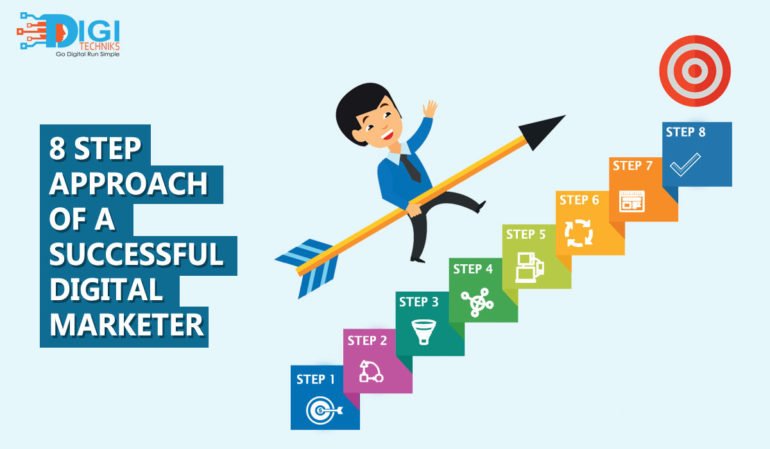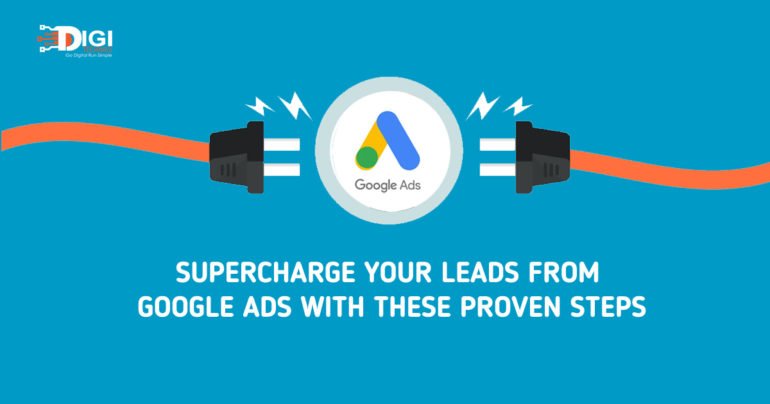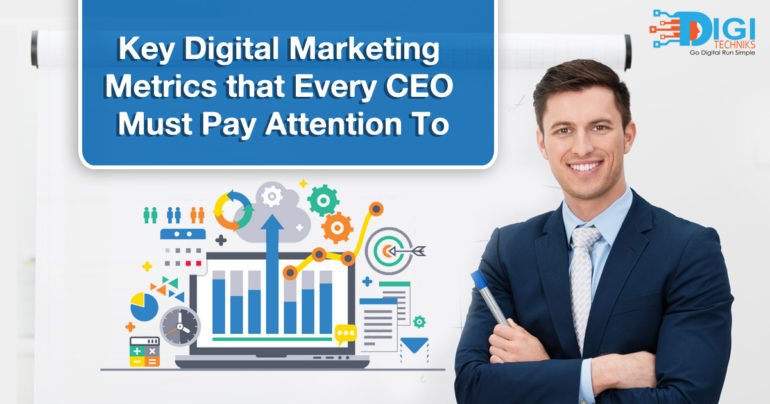
8 Step approach of a Successful Digital Marketer
There has never been a more exciting time to be a digital marketer. But it’s also harder and more challenging than ever before.
Just ask yourself the following questions:
- Can you accurately measure the ROI of your campaigns?
- Did your ad on the internet lead to an increase in sales?
- How many of those people who have shared your video or liked your Facebook posts have actually made purchases from your company?
Are you scratching your head trying to answer any of these? You’re not alone.
42% of marketers agree that proving the ROI of their marketing activities is one of the biggest challenges they face within their company.
Source: HubSpot’s State of Inbound Report, 2018Only 1 out of 4 marketers are confident in their ability to accurately measure digital media ROI.
Source: The Nielsen CMO Report, 2018
The ever-evolving digital landscape, newly emerging technologies, and savvier consumers are constantly keeping marketers on their toes. And more importantly, there is an increasing pressure on them to show the financial returns of their marketing efforts. Why? Because now, it’s all about providing results. Gone are the days when a digital ad campaign could be measured by the sheer number of site visitors or page views.
With top management in more and more organizations equating performance with ROI, you need to be able to show the value you create for every marketing penny spent. But that’s where the biggest challenge lies.
This guide will highlight three major problems that are stopping you from becoming a successful digital marketer, what you should do and eight steps to get there. We’ll pair each step with a practical “to do” section and how professional guidance by Digitechniks can help you master the step.
Problem 1: When you’re focused on the low-hanging fruit, you lose sight of the bigger picture
This is exactly what’s happening with a majority of digital marketers. They emphasize on generating more traffic and leads as a part of their digital marketing strategy, often ignoring the fact that these are low-hanging fruit that tell only part of the story.
67% of marketers consider increasing leads to be their top priority compared to 35% who prioritise converting leads into customers.
Source: 2019 B2B Marketing Mix Report, Sagefrog Marketing Group
In other words, most marketers are stuck at the top of the funnel and track their ROI in terms of the amount of traffic or leads they are getting.
The result? When their CEOs ask — “How does X video shares or X number of ‘likes’ tie directly back into our sales?” — they struggle to quantify these numbers.
That’s because unless you know how to nurture and convert the ‘likes’ and ‘shares’ into buyers, those numbers don’t really mean anything.
Problem 2: Without proof of work, you may fail to make a business case for your marketing initiatives
Consider this. The average cost per 1000 impressions on Google, Facebook or other digital channels falls anywhere between Rs.50-1500, depending on the industry and the nature of the business. That’s how much a company has to pay for 1000 Impressions on their digital ads.
With more businesses going digital, these numbers are going to rise even further in the coming days. No wonder, the stakes for marketers are higher than ever and there’s a mounting pressure on them to optimize campaign performance to win more customers.

In such a situation, without a solid ROI, it will be difficult to convince those who control the budgets that you’ll need to implement your digital plans. And often, without the right budget, you won’t be able to explore the full potential of your marketing initiatives or their effectiveness may suffer.
Problem 3: The error of looking at only one part of the process leads to wasteful drainage of resources
The problem is with marketers who focus on only driving more and more traffic to their websites is that they are only concerned with the top of the sales funnel.
But, more traffic doesn’t automatically mean more conversions. The ideal conversion rate (from traffic to customer) is around 0.5-3%. So their ROI is dependent on just this tiny percentage of the converted traffic. This means that they are leaving a lot on the table by not creating multiple touch points for the non-action takers.
When you look at the bigger picture, that’s negative ROI for a company. In other words, the money you’re putting into such marketing efforts is complete waste and your ‘boss’ or your client would be better off without spending it at all.
“What’s the ROI of a basketball? For me: A negative amount equal to the cost for repairing my torn meniscus. I have literally lost money playing basketball. For Kobe Bryant, on the other hand, the ROI is about $220 Million.” – Gary Vaynerchu
Also, if you’re paying too much attention to generating new leads and sales, it’s time to think whether you’re ignoring your existing customer base. Are you nurturing the customer relationships that you’ve already formed?
A lot of studies across many different industries have pointed out that acquiring a new customer is anywhere from 5 to 25 times more expensive than retaining an existing one.
Source: Multiple studies & reportsSolution: Change your mindset and approach
- Pump your digital marketing vehicles with the right fuel
Modern-era marketing demands strategies which involve more than just generating traffic and leads, and which have a direct correlation with sales and revenues. How to achieve this? The answer is, through a purpose-driven approach — something that we, here at Digitechniks, call “The Marketing Fuel”.
The Marketing Fuel – An arsenal of mindset, strategies, and tools to accomplish a marketing purpose that is in complete alignment with the company’s purpose.
All marketing channels — SEO, Social media, PPC, email marketing, etc. — are vehicles, but they need the marketing fuel to run at peak performance. If you don’t fill enough fuel or the right type of fuel in your marketing vehicles, they won’t run as smoothly or as fast as you desire.
Many aspiring digital marketers — and even those who are in the industry for years — are often not fully aware of what marketing fuel to use and when. This is mainly because they lack the knowledge of the entire digital marketing spectrum. Some of them stick to just one or two areas of digital marketing, which ultimately restricts their growth and leads to mediocre results for their clients.
For example, someone who has the knowledge of search engine optimization but doesn’t know what type of content impacts the reader and gets the clicks will eventually fail to create an effective campaign.
Therefore, in order to get your marketing fuel right, you need to gain a thorough understanding of digital marketing and the multiple niches and sub niches it includes. Specializing in one aspect of digital marketing is not enough.
- Start thinking in terms of ‘value’
You are probably hearing the term “customer-centricity” a lot these days. Well, it’s not a buzzword. It’s a real change that’s happening across the business landscape.
Gone are the days when marketing was all about making the sale and closing the deal. Today it’s more about creating a relationship with a customer. Only when that relationship has been established, will they buy your product or service. For these reasons, customer care is being touted as the new marketing.“
Customer value creation is at the heart of every successful marketing plan.”
— Andrew Stephen, Professor, Oxford University.
Therefore, as a marketer, it’s important that you have genuine interest in solving your customer’s problem as part of your marketing approach. Sales is the by-product of the care that you show for your customers.
Action: How to fire back your marketing vehicles with high-octane marketing fuel?
Too much noise on the web and social media leaves you with tonnes of plans and strategies but with very little to implement them. Let’s cut through the noise and get down to a practical action-plan that will bring some immediate changes in your digital marketing approach.
The following eight-step integrated digital marketing plan will allow you to make effective shifts in your approach and generate positive ROI for your campaigns, starting today.
Step 1: Define your Business Aspiration Goal
This first step sounds obvious but sadly it is not so. A lot of marketers, who are too eager to begin their campaign, often miss this point and launch their campaign without much of a practical plan, which is necessary for a productive outcome.

Besides determining who shall be your target customer and which market you plan to penetrate, it is important to set a goal that’s realistic. For example, you may want to gain 5000 new buyers by the end of a month-long campaign. But do you have enough resources and planning to reach this goal?
Starting with an unrealistic goal is setting yourself up for failure.
What to do
Evaluate your resources and decide on a revenue target that’s practically feasible. A good strategy is to work your way backwards from ROI to figure out what you need in order to bring the desired results. Also, take into account the problems you might encounter in achieving your revenue goals.
Don’t solely focus on your revenue goal. Business aspiration goal is divided into:
- Revenue Goal
- Customer-centric goals (The kind of value to be delivered to the clients in order to achieve the revenue goal)
- Team Goal (The kind of team that is required & has the potential to deliver the value to the customers)
- Team Learning Goals
How Digitechniks’s IDMCP can help
In our flagship Integrated Digital marketing certification program we have one complete module called Business Aspiration Goal Setting that will help you to set your Business aspiration goal.
Step 2: Build a business model to achieve your revenue goal
Stat: “A Business Makes Money Only When Their Offerings And Passion Meets The Demand”

Having a business model is important to create a sustainable business plan which can effectively communicate the key features of the business to the partners inside the company. But it’s equally important to make sure your business model is capable of achieving the revenue goals you’re targeting. If not, it’s probably time to think about modifying your business model.
You could do this by exploring new markets and/or creating new product lines. Also, with rising competition, one of the smartest and most effective ways to stand out is to move away from what others in your industry are doing. Steer clear of copy-cat brand models and think of how you can be a differentiator in your industry.
Can you please suggest an example that we can use here?
What to do
Build a magnetic brand to become a differentiator. A magnetic brand is one which fulfils the aspirations of the target audience and driven by purpose. In other words, your brand should offer unique services that your customers will get only from you and won’t turn to your competitors.
What if the heart of your business is in the right place and yet you’re struggling to grow your customer base? A simple way to get more customers for your products/services is to categorize them into three types:
1) Lead Magnets – Zero cost products/services that people won’t give a second thought before choosing. These are a great way to give your prospects a taste of your product/service. For example: Free sample-size products, a free webinar or a course etc.
2) Trip Wires – These products/services should be priced in a way that customers don’t have to spend too much money, yet are encouraged to make low-priced purchases that doesn’t seem much of a risk for them. For example: Low-cost versions of your core products/services or core products/services with limited features.
3) Core Product or Premium Solutions – These are your full-featured core products that customers would gladly pay for.
How Digitechniks’s IDMCP can help
In our flagship we have one dedicated module that will teach you how to carry out competitor analysis, market research and help you to build a brand that fulfills the aspiration of your target market.
Step 3: Build a Magnetic Marketing Funnel

Simply having a magnetic business model is not enough. In order to act on such a business model, you need an equally robust marketing funnel. In my experience, 90% of digital marketing plans fail due to the lack of a definite digital marketing funnel to acquire customers.
A marketing funnel defines an entire customer journey, from the initial stages when someone learns about your business to the purchasing stage. A powerful funnel is key to generating leads, converting them into customers, keeping them engaged, and making them your loyal customers.
Building a marketing funnel may seem like a lot of work but the effort is really worth both the time and money, given the fact there are so many companies who are targeting the same customers for their products and services every day.
Essentially, this is the step where you put into practice everything you’ve theorized in the first two steps.
What to do
- Build Lead Magnets
- Nurture your leads
- Engage leads with tripwire (irresistible offer which they cannot reject)
- Sell your core product/service
- Maximise your profits by upselling/down-selling/cross-selling
- Turn your customers into loyal advocates
Read our 6-step Customer Acquisition Formula in-depth.
How Digitechniks’s IDMCP can help
In our flagship Integrated Digital marketing certification program we have one complete module that will help you to build a funnel from scratch. This funnel allows you to generate ROI across any Digital Marketing platform
Step 4: Understand the Digital Ecosystem

New channels are constantly emerging in the digital landscape. For example, Snapchat and Instagram weren’t as popular a few years ago. But today, for certain types of businesses, these platforms are proving to be more effective than even Facebook or Twitter.
From SEO, SEM, to email and social media marketing initiatives, you’ll not only have to familiarize yourself with the entire digital ecosystem but also be on toes to keep up with the changes taking place.
At the same time, consumers are increasingly demanding a seamless and consistent experience across all these channels. This is also why in order to be successful as a digital marketers, you need to take a more strategic and integrated approach.
What to do
This step involves getting an in-depth understanding of all digital channels and platforms. Also, this is where you need to observe consumer behaviour, how they navigate the web, which platforms they frequently visit and when.
Understanding these behaviours can give you a ton of insights on the buying intent, purchase patterns, which messaging would work, and if the timing is right etc. For example, consumers on Google generally have a high buying intent, while those on Facebook may be simply browsing and don’t have a purchasing mentality right at that moment. By looking at the locations and hashtags of Instagram users you can tell if they are traveling — in that case, they may not be attentive towards a marketing message.
How Digitechniks’s IDMCP can help
IDMCP makes you well-versed with all the niches and sub-niches of internet marketing and provides practical knowledge about applying these concepts to create cohesive strategies for your clients. Through practical templates and real-life scenarios, we help you understand how every aspect of digital marketing such as SEO, SEM, social media, email marketing, and marketing automation work together as one cohesive force.
Step 5: Identify all the ideal Digital channels for your business
According to a report by MarketingProfs, around 2 million blog posts are written every day and there are more than 350,000 tweets every minute. With such huge information overload, it is important to find the right marketing channels through which you can reach your customer.
What to do
You can figure out your ideal channels through competitor analysis. Create a list of your competitors, pick a high-level competitor who is generating good traffic, identify their traffic sources, and be where they are.
Wondering if it’s a good idea to be where your competitors are already active? Imagine, how would it be to not enter a popular restaurant to enjoy their food just because it’s crowded? It’s almost similar.
Rather, think about how you can differentiate your existence on these platforms? High-quality content is your answer.
Tools for competitor analysis: SEMrush, Similarweb, Spyfu, Buzzsumo
How Digitechniks’s IDMCP can help
Our IDMCP program offers extensive competitor analysis guidance. We have competitor analysis templates that teaches you how to identify your ideal channels, how to build your presence through these channels, and the ways to set up a repeatable process to replicate your success.
Step 6: Build a process to use each of the digital marketing platforms efficiently

Every Digital Marketing platform has its own set of algorithms(rules). What works on one platform might not work on the other. Consider Google SERP as an example. Text based content performs (ranks) extremely well on Google search, whereas videos don’t. On Youtube however, it’s a completely different story.
Thus, it’s pivotal to understand each platform in detail & then decode it by building a process. This process can be used over & over again.
How Digitechniks’s IDMCP can help
In our Integrated Digital Marketing Certification Program we follow an accelerated learning technique that will help you build successful processes for any platform.
Step 7: Build templates for to simplify the above process
Building templates for each platform can provide you with a solid framework for analysing your goals and activities across the web, social media, SEO, PPC, email marketing, and the entire digital ecosystem. The four important KPIs included in any template includes organic sessions, organic landing pages report, organic keywords and organic conversions.
How Digitechniks’s IDMCP can help
In our Integrated Digital Marketing Certification Program we give you tried & tested templates that will help in speeding up the process. These templates can be tweaked according to your objectives.
Step 8: Aggregate the data from multiple templates to create a successful digital campaign

The final step involves getting the relevant data & measuring key metrics. Based on the data collected, it’s essential to extract insights. Key decisions have to be taken based on the insights.
In a nutshell, the purpose of collecting & measuring data is to:
- Know what’s working & what isn’t
- Take key decisions to further improve your digital campaign
How Digitechniks’s IDMCP can help
In our Integrated Digital Marketing Certification Program we teach you how to effectively mine data from the templates & processes (created in the previous steps) in a matter of minutes. You will learn how to identify the metrics that matter for your digital campaigns, and then take decisions to take your campaign to the next level (scaling). Become a digital marketing powerhouse in your organization with Digitechniks
Digitechniks was born to create employable and industry-ready digital marketing professionals. Our IDMCP training program is designed with this specific aim in mind.
This program gives you an in-depth understanding of digital marketing concepts through helpful tools, innovative learning techniques, and practical templates that will help you to not only capture and retain the information, but also apply it to real-world scenarios.
Our unique three-step teaching methodology:
A word from our trainer and mentor Sharan Kulkarni

Do your digital marketing strategies generate positive ROI? Well, mine certainly didn’t when I started out as a digital marketer. I slogged off hours creating campaigns that fell flat on face even before taking off. I was a failed marketer and a failed business owner, and didn’t really know what was tripping me over, again and again.
I decided to begin with a blank canvas and started to read books and online resources on marketing. Over the next few months, I realized that there’s so much good information out there but most of it is so mixed up with not-so-good information that it’s hard (and time-consuming) to pick out the good stuff.
I was actively reading blog posts, listening to podcasts, watching webinars and doing every imaginable thing to learn everything I could. What I also realized during this time is that most of the information available is great as theory but there’s very little guidance on practical applications.
It took me a little over a year to really get into the trenches of this vast ocean called ‘digital marketing’. And, it was instantly clear to me why so many digital marketers fail — they don’t have that amount of time to spare while learning about digital marketing.
Watching my career turn around inspired me to commit myself to transforming the life of marketers and business owners. The ‘Integrated Digital Marketing Certification Program’ (IDMCP) is the outcome of what I have learned through all these years.
In fact, this course is my digital marketing knowledge presented to you in a simple-to-follow and easy-to-implement manner.
Because I believe that if I can do it, you can do it too!








